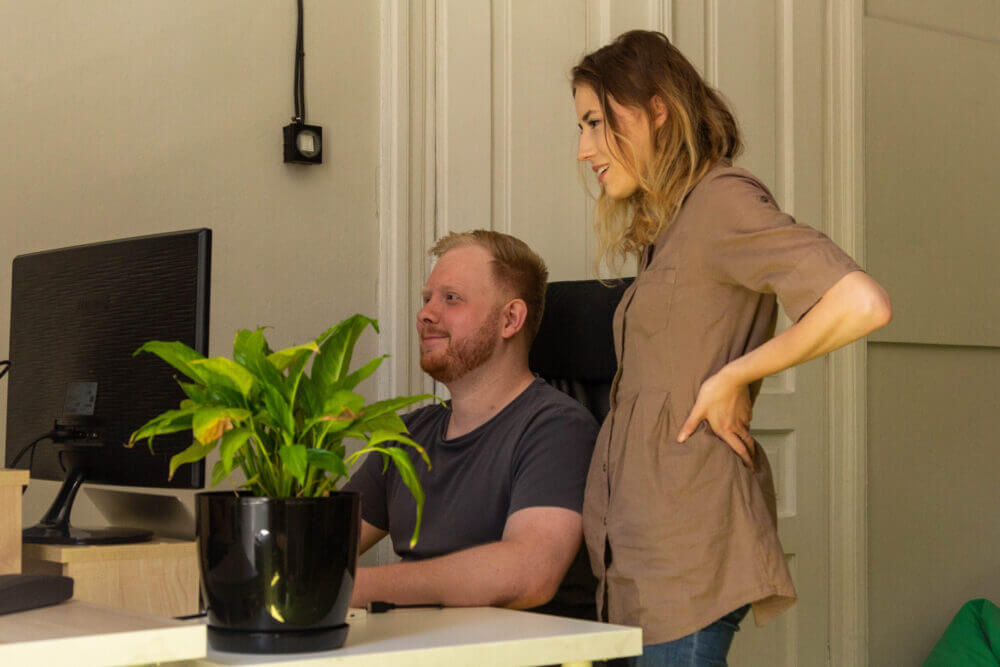The website is your office on the Internet. You invite customers, present them with your offer, tell them about your business. And just like you spend long hours arranging your office in the real world, you should also prepare for the creation of your website.
You need to create such a list, regardless of whether you design your website yourself or have it created by designers and developers. Why? You know your business best and your website should be a reflection and prolongation of it.

Therefore, a professional studio (freelancer or agency) should contact you at the beginning of the project implementation to ask you for the elements you can read about below.
How to prepare for the creation of the first website?
1. Who am I?
What do I do? What is the character of my work? What is my attitude to action? What do I rely on in my business?
Both the house and the office reflect the character of the owner. It should be similar with the website. That’s why you should start by defining what you do and how you want to be perceived (you, your company or your brand). If you want to work with designers, tell them (or write to them) what exactly your work is about. Understanding the industry and the range of services is an essential part of website development. If someone doesn’t understand your industry and doesn’t know what you’re doing, they probably won’t understand your customers either.
2. Purpose
What is your website created for? What do I want to attract my customers to?
A good website is always created for a purpose. “Everyone has a website now so we need one too” is not the best starting point. Make your needs clear: Should the website sell your products, present your services or encourage to contact you?
You can say that every website is always built to sell: the blog is supposed to sell the creations of the author, the shop the products of the owner and the portfolio the services of the photographer. But in each of these three cases, when preparing the website design, you focus on different elements: you will put different things on the home page, you will design call to actions differently, you will write in a different style. The more you describe what the website should do, the better the end result.
3. Customers
Who is the target group of the website? What would I find on my website if I was in their place?
In my opinion, questions about your customers are the most important questions you need to answer when creating a website or a website brief. A site that does not respond to the needs of customers will be like a city council which an angry petitioner leaves, having failed to settle an important thing. You wouldn’t want your customers to feel similarly when they visit your website, do you?
Consider who your customers are (where they come from, how old they are, what’s their education, status, interests, what they read, what they watch online, etc.) and what content they search online. This not only makes it easier to prepare the right structure of the website, but also gives you ideas for interesting articles to publish on the website. This makes it easier to find you on Google.
Keep in mind that the target audience of your website may be different customer groups.
If you want to be sure you’ve taken care of all the elements of the personality you’re creating, you can use the free online apps. I recommend two. The first is Xtensio – a very simple application that guides you step by step through the process of creating a persona or Userfoge, which gives you more freedom to shape your customers’ personality (and all you have to do is enter your name, your target group segment, your place of origin and your income).
4. Subpages and information architecture
What information should be placed on the homepage? Which subpages should be on my website?
If you decide to create a website with professionals, you should get a lot of support from them from that point on.

When you create a website, consider what information the visitor should receive when they first open your website. What should they see, how should they feel? Then consider which subpages should be put on the site and where the links to them should be displayed: in the page menu or in the individual sections?
When creating the structure of the website, make sure to make it as user-friendly as possible. Never hide the contact page – it should be easy to find and contain all the information needed. Also remember not to create unnecessary subpages and hide them in multi-level drop-down menus.
5. Marketing solutions
Do I need a newsletter, a contact form, a chat, a calendar of events, etc.? What interesting solutions have I seen on pages I like? What do I really want to implement?
Here too (at least in part) you should be able to rely on the work of a studio that knows where to place the call-to-action buttons and can offer you a variety of marketing tools. Is it worth choosing them? Yes, but carefully. Check which tools your competitors are using. Don’t copy everything as it goes, think about what is needed in your case. Do you need a newsletter subscription window if you do not communicate with recipients by e-mail? Do you need a chat window if there is no one to support it?
Non-functioning solutions are frustrating, so start with the ones you are sure you will make use of. When you create a site on WordPress, adding more extensions is not a problem.
6. Inspirations
Even the best graphic designer needs a starting point. “Something completely different from my previous website”, is a start, but the positive examples are much better. Search the Internet for websites of companies active in your industry and select some that you like. Don’t look only in the local market, you can find interesting and good looking websites in other countries too.
Send a list of these inspiring examples to the project working on your new website. Important note: The graphic designer cannot copy another page 100%, change the colours slightly and add your company logo. The pages you find should be an inspiration, not a tracing paper.
7. Photos, graphics, logo
We have already addressed the issue of photos several times on our blog. That shouldn’t surprise anyone. Even the best design loses a lot of quality when we complete it with bad pictures. Beautiful photos can add character and highlight any company wonderfully.
Prepare a package of pictures and graphics that you own. If you don’t have a nice picture of yourself, pay for it. If you don’t have beautiful photos of your company, organise a photo shoot or buy photos from stock sites. It is worth spending 150 zł for a dozen photos from the stock website and enjoying the perfect pictures.
In addition to the photos, think about your company logo.
8. Content
If you know what subpages your site will consist of, you can create the appropriate content for each page. The more accurate idea of your website you have, the easier it will be for you to design prepare content and elements of the website, such as counters, service information windows and headers.
Just like photos and pictures, you should also have content ready before starting the works on the website. This makes designing the individual elements easier.
9. Passwords, logins, accesses
When you create a website with an agency, remember to provide them with all the necessary information that will allow them to transfer the website to your server and connect your domain. If you don’t know what information is needed, ask. Sending all accesses including your credit card number and CVV code is nice but unnecessary ;).
What next?
- Modify – Don’t stick to what’s planned too strictly. If you notice that something doesn’t meet your expectations in the process of designing, change it.
- Listen to suggestions – When you use the help of an agency, don’t reject the ideas and suggestions they give you. Remember that these are experienced people who want to design the best website for you and your business.
- Be inquisitive – if something is unclear to you, ask.
How do I prepare to change the web design?
If you already have a website and would like to update or rebuild it, it is worth taking a look at the points above.
After several years of operating the website you will certainly have some conclusions or reflections about the way your website works. You may have noticed that your previous website did not fully meet your customers’ needs, or youcan see that your audience has changed. It is worth thinking about the information architecture and structure of the website once again – trends in web design are constantly changing, and what was fashionable a few years ago can now be outdated and inoperative.
Content and photos published on the previous site may also be out of date after a few years. As you can see, creating another website does not mean less work. But it may mean that you get the job done faster.
What you should keep in mind are the pros and cons of your previous website. Think about what you like about your old website and what are your biggest shortcomings? With such an analysis, you can re-implement elements that worked and get rid of unnecessary things. This information will also be useful for the studio you are working with.
Proper preparation for creating a website makes it easier for you to prepare it yourself and speeds up the work of the professionals when you decide to work with them. Be guided not only by your budget, but also by the knowledge that a good website with the appropriate marketing will quickly bring you benefits in the form of new customers and orders.
Checklist – creating/building a website
Answer these questions before starting the works on your new site.
- Am I creating the website by myself, or am I hiring a studio?
- Who am I and what do I do?
- What is my purpose? What is the purpose of my website?
- Who my customers are?
- How should the website’s architecture look like? How many subpages should it have? What subpages? What should be displayed on the homepage?
- What marketing solutions do I want to implement on my website?
- What other websites from my industry and similar industries do I like?
- Do I have a logo, photos and graphics that I will need?
- Do I have the content prepared?
- Do I have all the data prepared: server, domain, access to FTP?
Do you not know how to create your website? Contact us.
